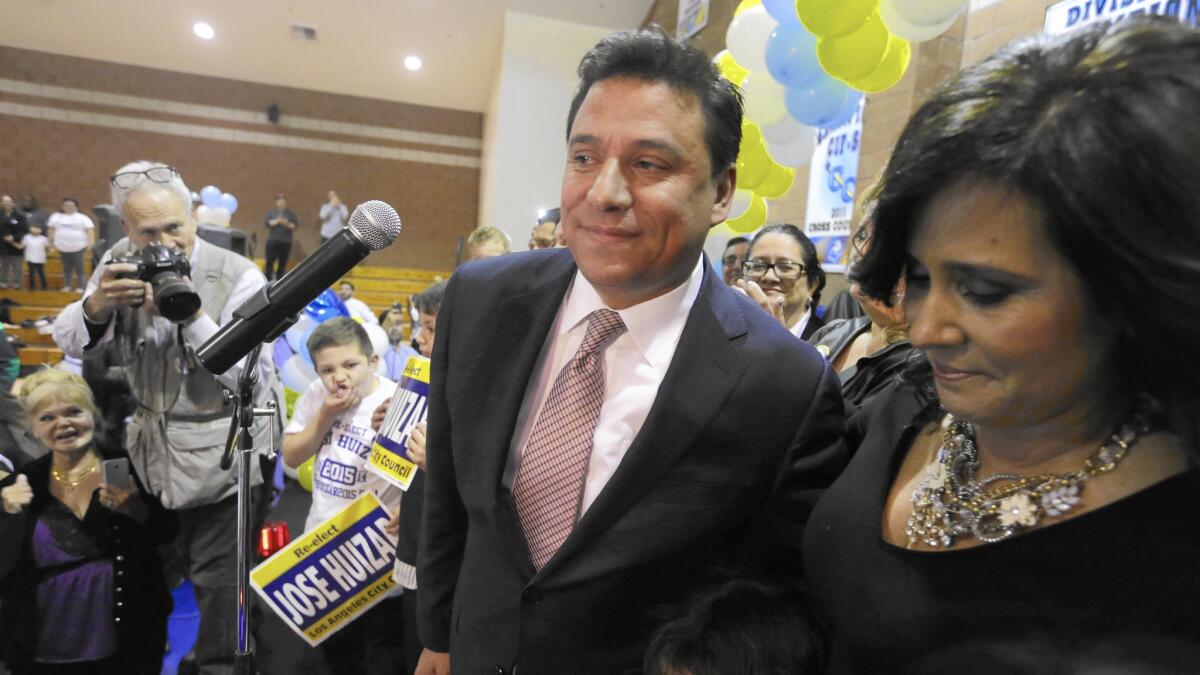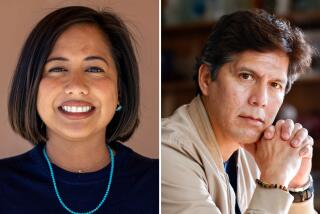First & Spring: Why the gap between Huizar and Molina became a canyon

- Share via
Six hours before the polls closed in last week’s City Council election, candidate and former L.A. County Supervisor Gloria Molina had a dozen people inside her Boyle Heights campaign office, calling up voters and urging them to get to their polling places.
Half a mile away, a similar effort was being carried out by her opponent, Los Angeles City Councilman Jose Huizar. But Huizar, running for his third and final term in office, had more than 60 people, most of them working the phones, crammed inside his crowded campaign office.
That disparity was just one of the many signs of the huge mismatch at play in the race for Huizar’s council seat. Huizar crushed Molina, pulling in nearly two-thirds of the vote. Molina struggled to hit 25%. What many expected to be a gripping showdown between two veteran politicians was instead a rout.
It was well known that Huizar had more endorsements and a lot more money. Yet Molina wasn’t some nobody. She’d been in office more than three decades. How did the gap between her and her opponent turn into a canyon?
For one thing, Huizar was popular in much of his downtown-to-Eagle Rock district, where he had worked to add new park space, sidewalks, bicycle lanes, street trees and other improvements. Those accomplishments were promoted in a series of high-profile rollouts — a street festival on Broadway in downtown, a park unveiling in Highland Park, a groundbreaking for the 6th Street bridge in the Arts District.
Molina, for her part, made a series of costly miscalculations. She entered the contest late, making it hard to catch up to Huizar’s fundraising and organization. She bungled a rollout of high-profile endorsements, including one from former Mayor Antonio Villaraigosa, who had previously held Huizar’s council seat. Molina also made statements on the campaign trail that alienated key groups: bicycle advocates, business leaders, supporters of downtown’s resurgence.
On top of all that, the City Hall establishment is, as a rule, very good at making sure its incumbents stay in office. This year, that establishment functioned as a well-oiled machine, said Scott Johnson, a Molina supporter who also writes for the blog Mayor Sam, which focuses on City Hall.
“They’re a little exclusive club and they want to protect one another,” he said.
Huizar spokesman Rick Coca dismissed the notion that the deciding factors were campaign funds and support from City Hall insiders, saying ultimately what mattered was the councilman’s performance. Many of the neighborhood improvements pursued by Huizar were years in the making, not something he came up with in the campaign’s final months, Coca said.
“The bottom line is he did the work,” he said.
Still, Huizar had plenty of help from the so-called city family—from his colleagues to the business interests that come before them. Most of the council’s 14 other members endorsed him, no big surprise given the relationships at play on the collegial council floor. Council President Herb Wesson raised money for Huizar’s reelection bid. Other council members rounded up volunteers, many of them political aides.
Days before the election, Councilman Bob Blumenfield walked door-to-door for Huizar, bringing seven staffers with him to help the campaign. Councilman Mike Bonin, who represents coastal neighborhoods, arrived at the campaign office with 10 volunteers, five of them members of his staff. An assortment of aides to Councilman Mitch O’Farrell also turned up to give Huizar a hand.
The labor unions that favored Huizar made an even stronger showing. Over the last weekend, United Firefighters of Los Angeles City Local 112 sent more than two dozen people to walk Huizar’s district. On election day, 60 volunteers with the hotel worker union Unite Here — coming from as far away as Orange County — fanned out across the district to persuade supporters to get to the polls.
That support was based in large part on two key votes: Huizar and his colleagues approved a hike in the minimum wage at hotels near Los Angeles International Airport in 2006. And last year, he backed a $15.37 minimum wage at the rest of the city’s larger hotels.
“For years, Jose has stood beside low-wage hospitality workers,” said Leigh Shelton, spokeswoman for Unite Here Local 11.
Then there was the financial disparity. Huizar raised more than $850,000 for his campaign, more than any previous council candidate running in an L.A. primary election. Once outside spending from unions, business groups and others are added in, contributions to Huizar’s reelection bid fell just shy of $1.5 million.
Huizar’s skills as a fundraiser played a big role in that effort. But he also excelled by starting his reelection effort in September 2013, a full year before Molina announced that she had decided to seek the seat. Molina ultimately raised around $225,000.
“I do absolutely think that if she was really determined to do this, she should have started much earlier,” said Fred Register, Molina’s campaign consultant.
Molina’s campaign appearances didn’t always help. At a downtown debate, she drew hisses from the audience after warning that downtown was losing too many parking lots. She baffled some in the business community by stating that downtown had become too dense. Those messages repelled voters like Heath Satow, who want to see more of the high-density housing that’s now under construction in downtown.
Satow, who lives in Boyle Heights and has a studio in the increasingly popular Arts District, went to the debate and concluded that Molina was “completely out of touch” with the changes happening downtown.
“She seemed absolutely clueless. It was a little scary. I was honestly worried she might get the position,” he said.
Register said Molina knew instantly after that event that she had made a “misstep,” one that cost her dearly in downtown. But he also argued that Molina’s overall struggle cannot be tied to any one appearance.
“Our polling indicated from the get-go that people were pretty happy with the direction of their neighborhood and the district and the city,” he said. “They knew and liked Gloria, but they knew and liked Jose just as much and maybe even better.”
Follow @DavidZahniser for more news from L.A. City Hall
More to Read
Sign up for Essential California
The most important California stories and recommendations in your inbox every morning.
You may occasionally receive promotional content from the Los Angeles Times.











